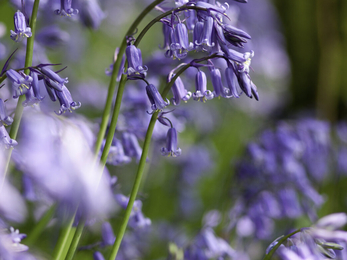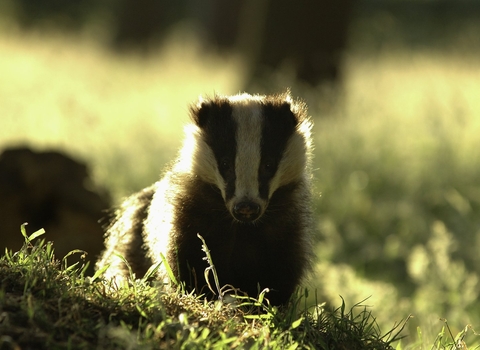What is the difference?
At a glance, native and Spanish bluebells can easily be dismissed as being the same, but a closer look reveals some easy to spot differences that will let you distinguish between the two easily.
The native bluebell
Our native bluebell, Hyacinthoides non-scripta, otherwise named common bluebells, English bluebells, British bluebells, wood bells, fairy flowers and wild hyacinth, is an early flowering plant that naturally occurs in the UK. It appears in ancient woodlands and along woodland edges in April and May. Millions of bulbs can exist in just one wood, giving rise to the violet-blue ‘carpets' that are such a springtime joy to walk through. This early flowering allows them to make the most of the sunlight that is still able to make it to the forest floor habitat, before the canopy becomes too thick. Native bluebells are protected in the UK under the Wildlife and Countryside Act, 1981.
Native bluebells have:
- narrow leaves, about 1-1.5cm wide
- deep violet-blue (sometimes white), narrow, tubular-bell flowers, with tips that curl back
- flowers on one side of the stem
- distinctly drooping stems
- a sweet scent
- cream-coloured anther (the part of the plant that contains the pollen)
The Spanish bluebell
The Spanish bluebell, Hyacinthoides hispanica, was introduced into the UK by the Victorians as a garden plant, but escaped into the wild – it was first noted as growing ‘over the garden wall’ in 1909. It is likely that this escape occurred from both the carefree disposal of bulbs and pollination. Today, the Spanish bluebell can be found alongside our native bluebell in woodlands and along woodland edges, as well as on roadsides and in gardens.
Spanish bluebells have:
- broad leaves, about 3cm wide
- pale blue (often white or pink), conical-bell flowers, with spreading and open tips
- flowers all around the stem
- upright stems
- no scent
- blue- or pale green-coloured anther
Does it matter that we have both in the wild?
The UK's woodlands are home to almost 50% of the world's population of the bluebell. But this much-loved plant is under threat. The Spanish bluebell is more vigorous than our native bluebell, so can outcompete it for resources like light and space. It can hybridise with our native, too, producing fertile plants that show a whole range of mixed features from both species. Over time, this hybridisation changes the genetic makeup of our native species, diluting its characteristics, weakening it and potentially evolving it into something else.
It is now thought that most bluebells in urban areas are actually hybrids. A study by Plantlife has also found that one in six broadleaved woodlands contained hybrids or the Spanish bluebell.
Does it make a difference what I plant in my garden?
Introduced species can become naturalised in the UK without much cause for concern. However, as with the Spanish bluebell, their effects are not always so benign, so be careful if you prefer non-native varieties in your planting as species can easily escape – it’s best to dispose of cuttings or bulbs carefully and never plant anything in the wild.
If you fancy planting bluebells in a shady part of your garden, try to pick the native variety. Not only will you help to prevent the spread of invasive, non-native species into the wider countryside, but you will also provide food and shelter for a range of our native insects, from bees to butterflies.





